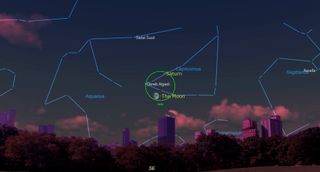See the moon and Saturn close together in the night sky tonight (Oct. 5)
The two celestial bodies may be nearly 900 million miles apart from one another, but they'll appear to be neighbors from our vantage point on Earth.

Look in the lower part of the southeastern sky after dusk tonight (Oct. 5) to catch the moon and Saturn cozying up to each other.
The duo will make a close approach (an appulse) and share the same right ascension (known as a conjunction), according to the stargazing website In-The-Sky.org .
The moon and Saturn will be visible next to each other from approximately 6:45 pm local time through 1:30 a.m. local time across the continental United States, appearing within the constellation Capricornus. They will be just 3°51' apart in the night sky — that distance is about one-third the width of your fist at arm's length, as held to the sky. The pair will be just close enough to share the view in most binoculars.
Related: The brightest planets in October's night sky: How to see them (and when)
In New York, the duo will come into view around 6:48 p.m. ET (1048 GMT) as the sky darkens, 22° above the southeast horizon. They will set around 1:36 a.m. ET (0536 GMT) in the southwest. Between rising and setting, they'll reach their highest point at 9:22, p.m. ET (0122) 32°.
In Los Angeles, the moon and Saturn will become visible around 6:47 p.m. PT (0147 GMT), reach their peak at 27° around 9:19 pm PT (0419 GMT), and set around 1:50 am PT (0850 GMT). They will also move from the southeast horizon towards the southwest horizon.
Saturn is the sixth planet from the sun, located an average distance of 854.45 million miles (1.375 billion kilometers) from Earth. It is visible with the naked eye, along with Mercury, Venus, Mars, and Jupiter.
Get the Space.com Newsletter
Breaking space news, the latest updates on rocket launches, skywatching events and more!
On Oct. 5, the moon will be in its waxing gibbous phase with an illumination of approximately 80% of a full moon.
If you're looking to enhance your view of the conjunction and appulse of the moon and Saturn, you can check out our guide for the best binoculars — both celestial bodies will be visible within the range of view of most binoculars. And if you're looking to photograph the event, here are our favorite cameras for astrophotography and the best lenses for astrophotography.
Though Saturn and the moon will not be close enough to see both simultaneously through a telescope, you can get great views of each individually with one; look through our picks for the best telescopes for some high-powered backyard stargazing. Saturn's rings should be visible with most telescopes.

Looking for a telescope to observe the moon? We recommend the Celestron Astro Fi 102 as the top pick in our best beginner's telescope guide.
Fancy taking a more in-depth look at our rocky companion? Our ultimate guide to observing the moon will help you plan your next skywatching venture, whether it be exploring the lunar seas, mountainous terrain or the many craters that blanket the landscape. You can also see where astronauts, rovers and landers have ventured with our Apollo landing sites observing guide.
Follow Stefanie Waldek on Twitter @StefanieWaldek. Follow us on Twitter @Spacedotcom and on Facebook.
Editor's Note: If you snap a photo of the conjunction of the moon and Saturn and would like to share it with Space.com's readers, send your photo(s), comments, and your name and location to spacephotos@space.com.
Join our Space Forums to keep talking space on the latest missions, night sky and more! And if you have a news tip, correction or comment, let us know at: community@space.com.

Space.com contributing writer Stefanie Waldek is a self-taught space nerd and aviation geek who is passionate about all things spaceflight and astronomy. With a background in travel and design journalism, as well as a Bachelor of Arts degree from New York University, she specializes in the budding space tourism industry and Earth-based astrotourism. In her free time, you can find her watching rocket launches or looking up at the stars, wondering what is out there. Learn more about her work at www.stefaniewaldek.com.
Most Popular

